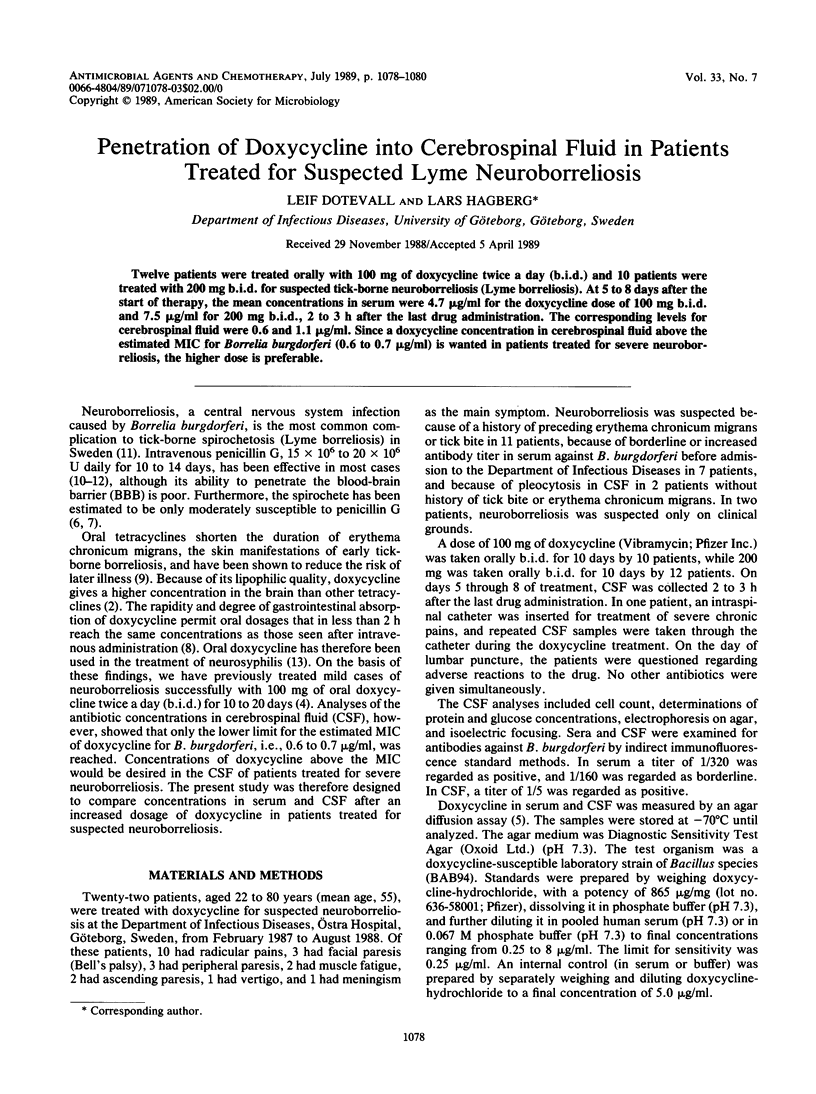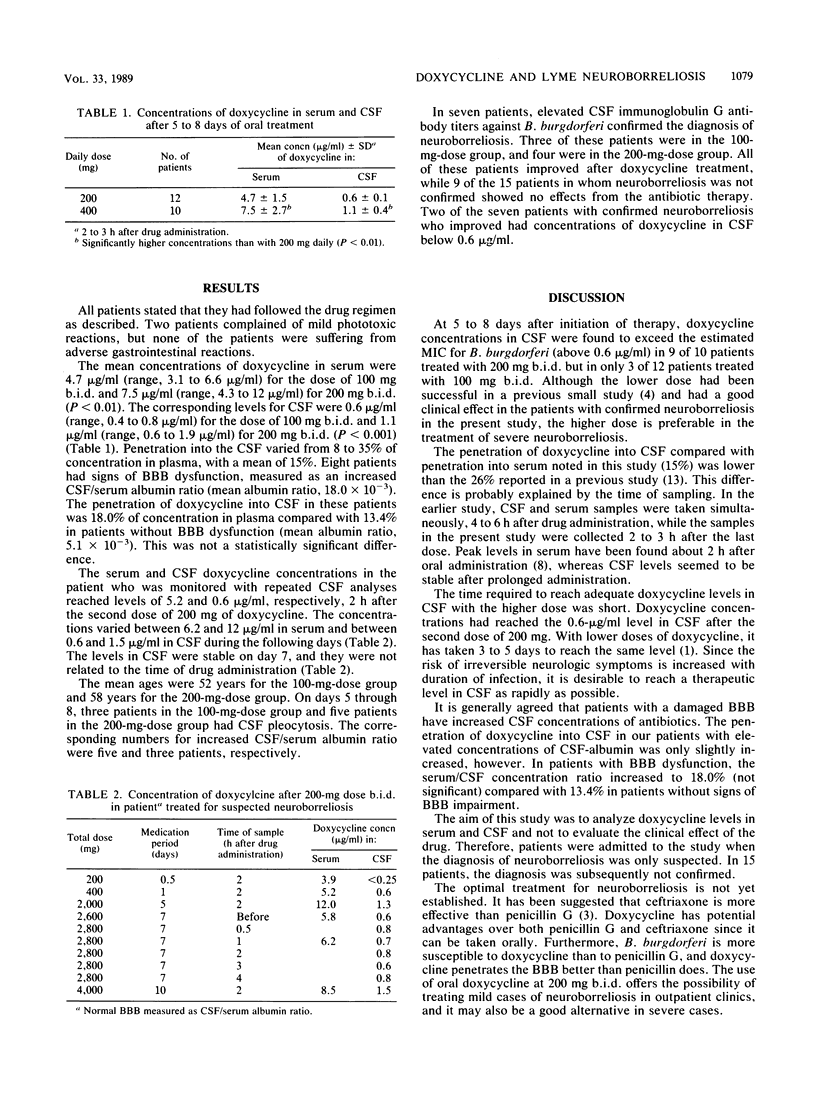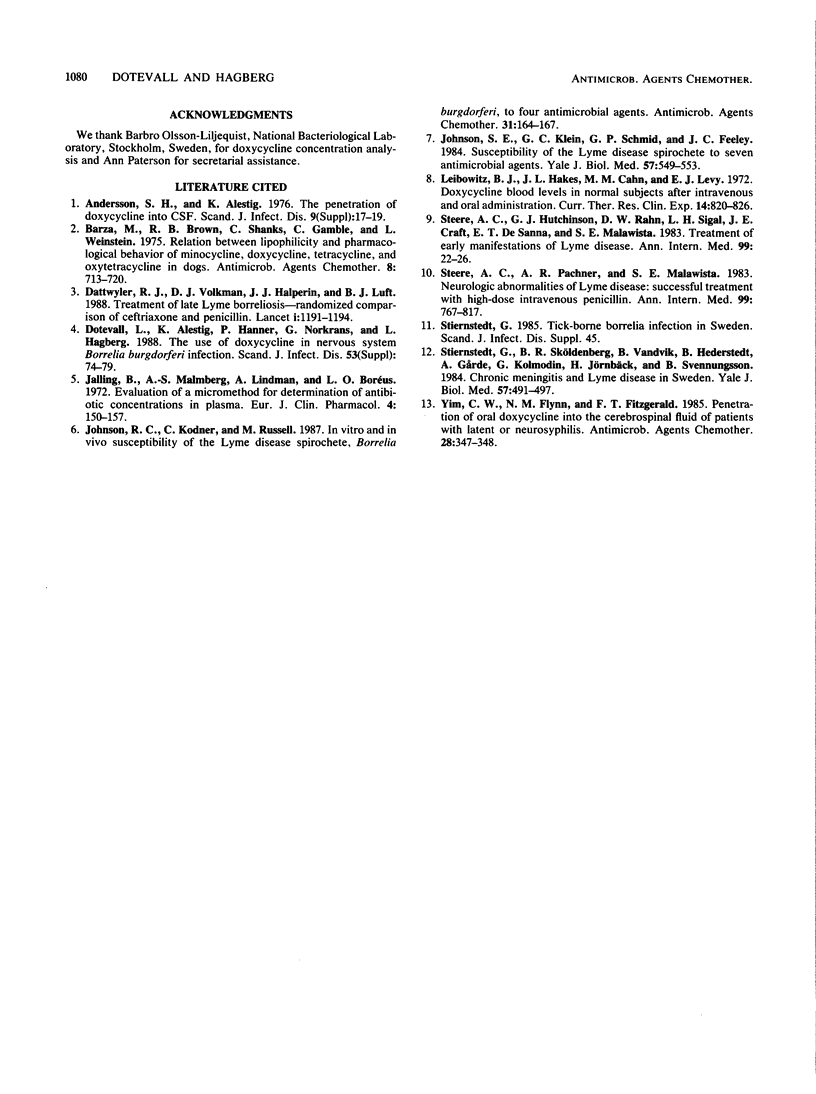Abstract
Twelve patients were treated orally with 100 mg of doxycycline twice a day (b.i.d.) and 10 patients were treated with 200 mg b.i.d. for suspected tick-borne neuroborreliosis (Lyme borreliosis). At 5 to 8 days after the start of therapy, the mean concentrations in serum were 4.7 micrograms/ml for the doxycycline dose of 100 mg b.i.d. and 7.5 micrograms/ml for 200 mg b.i.d., 2 to 3 h after the last drug administration. The corresponding levels for cerebrospinal fluid were 0.6 and 1.1 micrograms/ml. Since a doxycycline concentration in cerebrospinal fluid above the estimated MIC for Borrelia burgdorferi (0.6 to 0.7 microgram/ml) is wanted in patients treated for severe neuroborreliosis, the higher dose is preferable.
Full text
PDF


Selected References
These references are in PubMed. This may not be the complete list of references from this article.
- Andersson H., Alestig K. The penetration of doxycycline into CSF. Scand J Infect Dis Suppl. 1976;(9):17–19. [PubMed] [Google Scholar]
- Barza M., Brown R. B., Shanks C., Gamble C., Weinstein L. Relation between lipophilicity and pharmacological behavior of minocycline, doxycycline, tetracycline, and oxytetracycline in dogs. Antimicrob Agents Chemother. 1975 Dec;8(6):713–720. doi: 10.1128/aac.8.6.713. [DOI] [PMC free article] [PubMed] [Google Scholar]
- Dattwyler R. J., Halperin J. J., Volkman D. J., Luft B. J. Treatment of late Lyme borreliosis--randomised comparison of ceftriaxone and penicillin. Lancet. 1988 May 28;1(8596):1191–1194. doi: 10.1016/s0140-6736(88)92011-9. [DOI] [PubMed] [Google Scholar]
- Dotevall L., Alestig K., Hanner P., Norkrans G., Hagberg L. The use of doxycycline in nervous system Borrelia burgdorferi infection. Scand J Infect Dis Suppl. 1988;53:74–79. [PubMed] [Google Scholar]
- Jalling B., Malmborg A. S., Lindman A., Boréus L. O. Evaluation of a micromethod for determination of antibiotic concentrations in plasma. Eur J Clin Pharmacol. 1972 Jun;4(3):150–157. doi: 10.1007/BF00561138. [DOI] [PubMed] [Google Scholar]
- Johnson R. C., Kodner C., Russell M. In vitro and in vivo susceptibility of the Lyme disease spirochete, Borrelia burgdorferi, to four antimicrobial agents. Antimicrob Agents Chemother. 1987 Feb;31(2):164–167. doi: 10.1128/aac.31.2.164. [DOI] [PMC free article] [PubMed] [Google Scholar]
- Johnson S. E., Klein G. C., Schmid G. P., Feeley J. C. Susceptibility of the Lyme disease spirochete to seven antimicrobial agents. Yale J Biol Med. 1984 Jul-Aug;57(4):549–553. [PMC free article] [PubMed] [Google Scholar]
- Leibowitz B. J., Hakes J. L., Cahn M. M., Levy E. J. Doxycycline blood levels in normal subjects after intravenous and oral administration. Curr Ther Res Clin Exp. 1972 Dec;14(12):820–832. [PubMed] [Google Scholar]
- Steere A. C., Hutchinson G. J., Rahn D. W., Sigal L. H., Craft J. E., DeSanna E. T., Malawista S. E. Treatment of the early manifestations of Lyme disease. Ann Intern Med. 1983 Jul;99(1):22–26. doi: 10.7326/0003-4819-99-1-22. [DOI] [PubMed] [Google Scholar]
- Steere A. C., Pachner A. R., Malawista S. E. Neurologic abnormalities of Lyme disease: successful treatment with high-dose intravenous penicillin. Ann Intern Med. 1983 Dec;99(6):767–772. doi: 10.7326/0003-4819-99-6-767. [DOI] [PubMed] [Google Scholar]
- Stiernstedt G. T., Sköldenberg B. R., Vandvik B., Hederstedt B., Gårde A., Kolmodin G., Jörbäck H., Svenungsson B. Chronic meningitis and Lyme disease in Sweden. Yale J Biol Med. 1984 Jul-Aug;57(4):491–497. [PMC free article] [PubMed] [Google Scholar]
- Yim C. W., Flynn N. M., Fitzgerald F. T. Penetration of oral doxycycline into the cerebrospinal fluid of patients with latent or neurosyphilis. Antimicrob Agents Chemother. 1985 Aug;28(2):347–348. doi: 10.1128/aac.28.2.347. [DOI] [PMC free article] [PubMed] [Google Scholar]


